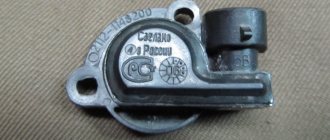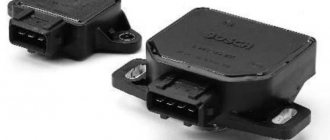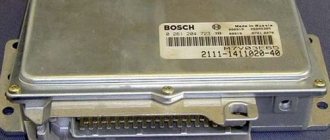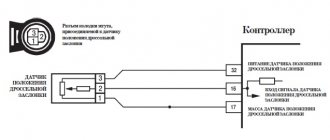People are often interested in what signs of a malfunctioning throttle sensor on a VAZ 2110 exist. Knowing all the signs of a malfunction is simply necessary. Indeed, often when this sensor breaks down, drivers cannot find the cause for a long time. All parts and assemblies whose malfunctions manifest themselves in a similar way are replaced. And only when nothing helps, they pay attention to the damper position sensor (DPS). And a lot of time and money was spent. If they had checked it right away, there would have been fewer problems with repairs.
There are several signs of a car breakdown, in which case this sensor should be checked first and, if necessary, repaired.
Diagnostics
Signs of a malfunctioning throttle sensor on the VAZ 2110 are not too different from other models. But there are some features that are worth paying attention to. The following signs may indicate a malfunction of the TPS:
- Floating idle speed until the engine stops in neutral;
- Jerks during acceleration, the car jerks and accelerates extremely difficult;
- Check Engine
light is on .
These signs can usually indicate more than just problems with the throttle sensor. That's why drivers rush to check everything except TPS. Many people are also afraid of getting into electronic systems.
The ideal option is diagnostics using a special scanner. This allows you to recognize the cause of the phenomena without any problems. The error code can be 0122 or 0123. When the signal is low, the first code is issued, and when the signal is high, the second. Such computer readings indicate a clear problem with the sensor. Code 0122 may indicate problems with the wiring supplying the TPS.
Be sure to check all wiring for damage. If you don’t have a scanner at hand, then when checking all the elements, you should first check the throttle and its sensor.
Principle of operation
. To properly check the TPS, you need to know the features of its operation. This sensor is a potentiometer that transmits all information about the position of the throttle valve to the controller. It works as follows. By pressing the gas, you change the position of the damper, and the sensor reacts to this. There is a constant voltage at its outputs, which can vary.
The controller reads the readings from it and, based on this data, doses the fuel supply. If the TPS malfunctions, incorrect readings are given, and as a result, the fuel supply begins to be unstable. And you may notice malfunctions in the engine.
Location
. To check the device in detail, you need to find it. This is quite easy to do. In the VAZ 2110, the throttle sensor is located on the throttle pipe. It connects to the throttle shaft. This directly ensures the operation of the device. The sensor is secured with two screws.
Procedure for replacing the sensor
To get the job done, you only need a medium sized screwdriver. The sequence of actions is as follows:
- Disconnect the block with wires from the sensor.
- Unscrew the two mounting screws.
- Remove the sensor.
- Replace the foam pad.
- Install a new sensor.
- Connect the electrical block.
Thus, replacing the TPS yourself does not pose any problem, although there is one “but”. The sensor is tested by the vehicle's on-board computer. In the event of a malfunction, the “Check engine” is turned on. So, even after installing a new TPS, the alarm will not go off. You will have to disconnect the battery terminal for 15 minutes or reset the error in another available way.
Examination
In addition to checking the sensor itself, pay attention to the condition of the throttle valve. Sometimes it becomes coked, and as a result its mobility is lost. In this case, symptoms similar to sensor failure will also be observed.
The simplest check of the sensor’s functionality can be done even without removing it from the car:
- To do this, turn on the ignition and measure the voltage at the TPS terminals, it should not exceed 0.7 V;
- Next, use the plastic sector to fully open the throttle. Then the voltage is measured again. The normal value is at least 4B;
- Then check the correct operation of the sensor. To do this, you need to measure the voltage at the TPS terminals when the damper moves.
- It should not jump sharply, all changes should occur smoothly. Abrupt changes indicate a malfunction of the device;
- The final check is to check the resistance between any of the terminals and the slider contact. To do this, turn off the ignition and pull out the connector. When turning the damper, this indicator should change evenly.
If you find out that the sensor is faulty, you should replace it. It is important to choose this design element correctly. The VAZ 2110 is equipped with 2 types of TPS. One of them is film resistive. This type is installed by the manufacturer, the sensor is designed for 55,000 kilometers. The other type is called non-contact. It uses a Hall sensor. This device has no restrictions on its service life. But it costs a little more.
Conclusion
. The “ten” is equipped with a familiar sensor. The same version of the device is installed on this entire family. In this regard, all signs of a malfunction of the throttle sensor on the VAZ 2110, with the exception of minor nuances, are similar on all cars with this sensor model. Timely repairs will save you from the hassle of having a poorly functioning machine.
The throttle unit (DU) is responsible for supplying air to the engine of the VAZ 2110 car. The enrichment of the fuel mixture with fresh air depends on its operation. And if the throttle assembly is damaged, then the functioning of the power plant is disrupted. If it breaks down, the remote control is replaced with a new one, but sometimes the result of a malfunction can be contamination of the unit or a broken TPS - throttle position sensor of the VAZ 2110. You can do both cleaning and replacement yourself.
Helpful advice: cleaning and changing the gasket is necessary every 50-60 thousand kilometers. This figure is suitable for almost all VAZ models. Then repairs and replacements will not be required. Cleaning will cost only 150-200 rubles.
Buying a new sensor
The car manufacturer VAZ, when assembling injection cars, installs domestically produced resistive film sensors on them, which differ only in their very short service life. The price of such a device is small - within three hundred rubles, so there is no point in repairing it. Replacing the VAZ 2110 throttle sensor, in this case, will be the best solution.
The internal structure of a proximity sensor essentially consists of a rotor and a stator. The rotor itself is made of a material that cannot be affected by a magnetic field, and a magnet is located on its base. The stator, on the contrary, is an element that ideally senses the magnetic field (the so-called Hall element). It is located at a distance from the magnet, which has a constant value, and during the assembly of the device itself is programmed in a certain way. This invention is used in the automotive industry for installation in an electronic control system. For the VAZ 2110, replacing the throttle position sensor with a non-contact version will be the best solution. Despite the fact that such devices are twice as expensive as film-resistive devices, they are much more reliable in operation and last much longer.
Location and main malfunctions of remote control and TPS
To clean or replace, we need to find the throttle assembly. In a VAZ 2110 car it is located in the engine compartment on the throttle pipe. A malfunction of the damper can be determined by the following signs:
- There are noticeable jerks when accelerating.
- Increasing idle speed.
- "Check Engine" indication.
- At neutral speed the engine stalls.
- Decrease in dynamics.
- "Floating" speed.
Removing the throttle assembly
Dismantling the remote control will be necessary in any case. If there are malfunctions, the unit is replaced with a new one, but if there are no problems other than contamination, then the gasket on the damper is changed, and then a thorough cleaning is performed. For dismantling you will need a set of screwdrivers and a 13mm socket wrench. You also need to purchase a special cleaning fluid, which can be found at any car store. An excellent option would be a product for carburetors - Arbo. Dismantling is carried out only on a “cold” motor.
Cleaning
So, the part has been removed. Now you need to assess the condition of the gasket. If cleaning is being done for the first time, the gasket should be replaced. Cleaning is carried out using a pre-prepared product, cotton swabs and a toothbrush. We need to clean all cavities and hidden channels. The damper itself and the landing sites need to be given special attention.
As a result, the remote control must be completely cleaned of grease and dust. Before installation, it is worth cleaning the crankcase ventilation duct. Here you will need a foot pump. It is better to perform purging with the same product.
Troubleshooting throttle position sensor
The cause of the defects described above may be a faulty VAZ 2110 TPS. This element is necessary to inform the controller about the position of the damper immediately after the gas pedal changes its position. The voltage at the TPS output is constantly changing - this allows for the correct supply and dosage of the fuel mixture.
If the TPS malfunctions, malfunctions begin, as information about the throttle position is supplied incorrectly. Because of this, excessive fuel consumption or interruptions in the operation of the power plant may occur. Sometimes cleaning the surface of the sensor itself solves the problem. But if the TPS is damaged, then only replacement will help. The replacement process is very simple. It is necessary to remove the old sensor and install a new one in its place. No additional work is required.
How to get rid of moving parts
If it turns out that the TPS is faulty, then it is advisable not to skimp and install a contactless sensor when replacing it. Its main element is a Hall sensor, very reliable, with no moving parts at all. It records with great accuracy all changes in the magnetic field when the throttle angle changes and transmits it to its own electronic circuit. When replacing the sensor, no changes to the design need to be made. It is enough to simply dismantle the old one and install a new TPS.
What is TPS in a VAZ-2110 car?
The throttle position sensor is abbreviated as TPS among motorists. This part is used in several types of engines:
- Gasoline injection type.
- Single injection type.
- Diesel engines.
TPS is also known as a throttle valve potentiometer. This is due to the fact that the sensor is designed to function as a variable resistor. The sensor itself is installed in the engine compartment - the place of fixation is the throttle pipe. The mechanism of operation of the sensor is as follows: depending on the position and degree of opening of the throttle valve, the resistance also changes. That is, the level of the value of such resistance depends on the pressing of the gas pedal. If the pedal is not pressed, the throttle valve will be closed and the resistance will be minimal. The opposite is true when the damper is open. Accordingly, the voltage across the TPS, which is directly proportional to the resistance, will also change.
The control of such changes is carried out by the electronic control system; it is the one that receives all signals from the TPS and supplies fuel using the fuel system.
So, at the maximum voltage of the signal contact of the throttle position sensor, the fuel system of the VAZ-2110 car will supply the largest portion of fuel.
Thus, the more accurate the TPS indicators, the better the VAZ-2110 electronic system adjusts the engine to the correct operating mode.
Types of sensors for VAZ 2114
The resistive throttle sensor of the VAZ 2114 is the simplest and cheapest, but it has a huge disadvantage - the sensitive part wears off over time, and at idle the speed becomes unstable. Among this type of devices, the most popular are the TPD and Kursk companies. According to reviews from motorists, these sensors last a long time and are highly reliable. But these parameters are higher for contactless devices, for example, those produced by Avtoelektrika. There is no resistive layer - there is nothing to wear out, therefore, reliability and service life become higher.
Price of throttle sensors for VAZ 2114:
- Resistive - from 130 rubles.
- Contactless – about 300-500.
The TPS is located directly on the throttle mechanism, secured to it with bolts. The axes of the sensor and the damper are in the same plane.
Communication of the throttle valve with other automotive systems of the VAZ-2110
The throttle valve of a VAZ-2110 car is a component of the engine intake system and is directly connected to a large number of other vehicle systems. These include the following systems:
- directional stability;
- anti-blocking;
- anti-slip;
- anti-slip;
- cruise control.
In addition, there are those systems that are controlled by the electronics of the gearbox. After all, it is this throttle valve that regulates the flow of air into the car system and is responsible for the quality composition of the fuel-air mixture.
TPS design
The throttle position sensor can be of two types:
In its design, it resembles an air valve - in the open position the pressure corresponds to atmospheric pressure, in the closed position it drops to a vacuum state. The TPS includes DC and AC resistors (each resistance is 8 ohms). The process of opening and closing the damper is monitored by the controller, with subsequent adjustment of the fuel supply.
If at least one symptom of a malfunction occurs in the functioning system of this sensor, then fuel may be supplied to the engine either in excess or in deficiency. Such malfunctions in engine operation are reflected in the engine of the VAZ-2110 car and on its gearbox.
HOW TO CHECK ITS WORK INDEPENDENTLY
You already know the signs of a malfunctioning throttle position sensor, let's try to check its functionality ourselves. A sequenced test cycle will help you check how to check the throttle position sensor. To perform this, you need to have a tester, a multimeter or a simple voltmeter with a scale of 15-20 volts.
The verification procedure will be as follows:
- You need to open the hood and find the TPS. Look for it near the throttle valve;
- To check, a connector from this sensor is required, so it is disconnected from the TPS;
- Now a voltmeter or other devices are connected to work in voltage measurement mode. The “minus” of the device is connected to the “ground” of the car, and the voltage will be checked with the second probe. Carefully examine the connector body and find the terminal marked with the letter “A”.
- With the ignition on, check for voltage at this terminal. It should be equal to 5 volts. If there is power, then the TPS is out of order and must be repaired or replaced. If the voltage is significantly lower than 5 volts or is absent at all, it is necessary to check the entire electrical circuit of its power supply. If everything is fine with it, the controller may fail.
You can check the operation without disconnecting the connector from the TPS. Let's look at this technique in action, how to check the TPS without disconnecting it from the power supply. The purpose of the test remains the same, this is to check the presence of supply voltage at the TPS. With the ignition on and a voltmeter connected, the device should show a smooth voltage change from 0.7 to 4 V if you smoothly turn the plastic throttle sector. The TPS connector must be connected, and the supply voltage is checked by calcining the wire with the probe of the measuring device.
If you have an ohmmeter, you can check the resistance of the sensor potentiometer. In this case, the connector is disconnected from the TPS, and the ohmmeter probes must be connected to any fixed and moving contacts. When the sector rotates, the meter needle should move smoothly. Jerking or jerking movement of the instrument needle is evidence of its malfunction.
Characteristic symptoms of a malfunctioning TPS condition
Thanks to the correct functioning of the throttle position sensor, the fuel system of the VAZ-2110 car engine works with a smoothing effect. That is, the vehicle moves smoothly, and the gas pedal responds well to pressure. Therefore, a malfunction of the TPS can be noticed almost immediately by the following signs:
- Poor engine starting.
- Noticeable increase in fuel consumption.
- The car's movements are intermittent.
- The idle speed of the engine is noticeable when running.
- The Check e light comes on on the dashboard
- The car accelerates poorly due to delays in acceleration.
- Popping sounds are heard in the intake manifold.
Of course, these signs of a faulty sensor may not all be observed at once. But even if you notice only one of the above symptoms, it is worth carrying out computer diagnostics of the vehicle at a service center.
Is your TPS connected to ground?
- Carefully disconnect the electrical connector from the throttle position sensor.
- Check the connector and terminal for dirt or damage.
- Set the multimeter to a suitable mode, for example, 20V on the DC voltage (DCV) scale.
- Turn the ignition key to the ON position, but do not start the engine.
- Connect the red multimeter probe to the positive terminal of the battery, indicated by the “+” symbol.
- Touch the black probe of the multimeter to each of the three electrical contacts of the wiring connector that connects to the TPS.
* One of the contacts, when touched, a voltage of about 12 volts appears on the multimeter screen, is the ground contact. Pay attention to the color of this wire.
*If none of the terminals indicate 12 volts, this is a sign of a defect in the wiring that goes to the throttle position sensor. The sensor is not grounded, so it cannot work properly. In such a situation, you need to solve the wiring problem.
Checking the operation of the throttle position sensor
To check the TPS yourself, it is not necessary to call an auto electrician for consultation. To do this you need a multimeter or voltmeter. Next, experts offer step-by-step instructions for checking the sensor.
The first step is to turn the key in the ignition switch, take the voltage readings between the sensor slider contact and the minus. In normal condition, the indicator will be up to 0.7 V.
The second step is to turn the plastic sector and open the damper, and then take measurements again. In the normal state of the sensor, the device will show a result of 4 V.
The third step is to turn on the ignition completely (as a result of this the connector will stretch out), measure the resistance between the slider and any terminal. When rotating the sector, you must monitor the measuring device:
- when the multimeter or voltmeter needle moves smoothly, the sensor is working;
- when the needle on the meter shows sudden changes, the DPPZ is faulty.
Once the sensor is faulty, it can be adjusted or replaced. The VAZ-2110 car repair service center will tell you how to do the right thing.
As you know, the VAZ 2110 was produced with injection and carburetor engines. The injectors are equipped with an impressive number of sensors, the performance of which determines the functionality of important units. Therefore, if they break down, problems may arise in moving, power decreases, fuel consumption increases, and much more.
A prime example of an important sensor is the throttle position sensor. Today we’ll talk about it in more detail.
The throttle position sensor is responsible for determining the current throttle position. Depending on this, the fuel supply system changes the amount of fuel supplied under one or another operating mode of the power unit.
If problems arise with it, you can contact a service station so as not to waste your energy and nerves. But in practice, changing the TPS yourself is quite simple, plus you will save a decent amount of money.
The desired regulator is located on the side of the throttle pipe on the throttle valve axis.
Regulator location
Features of work
The TPS is essentially a variable resistor, one output of which is supplied with 5 Volt power. The second contact is connected to ground, and the third is connected to the controller.
When you press the gas pedal, the voltage changes. The sensor monitors the output voltage on the controller, thereby regulating and monitoring the quality of the supplied air-fuel mixture. This directly depends on the opening angle of the damper itself.
If for some reason this regulator fails, a catastrophe will not occur, since another sensor, the mass air flow sensor, will temporarily take over its functions.
This does not mean at all that the TPS can not be changed. Each regulator has its own functions, so there is no point in transferring the tasks of the TPS to the MAF.
There are several telltale signs of trouble that may indicate that there is a problem with the throttle valve control.
- High idle speed;
- When the gear is switched off, the engine may stall;
- When the car picks up speed, the car jerks and jerks are felt;
- Acceleration dynamics deteriorate significantly;
- Floating speed occurs at idle.
It should be noted that similar symptoms may also be characteristic of the failure of other components - the idle speed control or the ignition module, for example. Therefore, you first need to check the TPS.
Checking the status of the regulator
Next, let's talk about how you can check this throttle valve sensor. The event is necessary because it allows you to understand whether all the troubles are really due to it, or whether the problems arose due to the failure of other elements of your car.
It’s not uncommon for novice car owners to make hasty conclusions based on the primary signs of a breakdown. This results in unnecessary repair work and costs.
To check the current status of the throttle position sensor you need to:
- Measure the voltage at the output of the slider, turning on the ignition and opening the idle contacts;
- If the test shows that the voltage is more than 0.7 volts, then the sensor has indeed failed;
- Open the damper completely. In normal condition, voltage readings should be no more than 4 volts;
- Measure the variable resistor for resistance;
- To do this, connect an ohmmeter or a multimeter in ohmmeter mode to the power supply and output;
- Slowly begin to turn the throttle;
- At the same time, monitor the readings on the device;
- If, as the damper opens, the resistance also changes slowly, then the unit is working properly.
If you find during the test that the sensor is faulty, you only need to replace it. It cannot be repaired.
The resistive layer along which the slider moves wears off over time due to friction. Because of this, the regulator begins to produce incorrect data, the characteristics of the supplied mixture change, and engine performance deteriorates.
Disabling the regulator
In fact, changing this sensor is insanely easy. So don't rush to send your car to a service station. Everything can be done with your own hands, the quality will not suffer from this.
- To remove the throttle position sensor, you first need to find it.
- As we have already noted, the desired unit is located on the side of the throttle pipe on the throttle valve axis.
- Having found the element, pick up a shaped screwdriver.
- Using this simple tool, unscrew a couple of bolts that hold the device.
- Pay special attention to the gasket that is available under the old regulator. We do not recommend using it again; it is better to immediately buy a new one. Often the gasket is already included with the throttle sensor itself.
- After removing the old sensor, you can slightly clean the place where it is installed if there is dirt there.
- Next, a new sensor is installed along with a new foam gasket and the bolts are tightened.
- Try to tighten the fasteners as far as possible, otherwise the new throttle sensor will quickly lose its effectiveness. The work will have to be done again.
- There is no need to make any adjustments after replacement.
- The zero mark on the controller will determine that the throttle is completely closed.
Possible faults
The contact-type sensor is quite reliable, and according to the designers’ plans, it should last at least 50,000 km. This is ideal under average operating conditions. In practice, it often fails before reaching half of its intended lifespan. Like any mechanics, the controller is very demanding regarding various clearances, frequency and speed of movement of the slider. The situation is complicated by the difficulty of diagnosis. The main symptoms of a malfunction of the VAZ-2110 throttle sensor are very similar to damage to many other components of the car. However, symptoms of TSD damage may include the following:
- deterioration of engine dynamic characteristics;
- jerking during intense acceleration;
- stopping the engine when changing gears;
- “dips” when sharply pressing the gas pedal.
As already noted, the weak point of the TPS is the mechanical moving contact. The resistor slider, moving across the resistive layer, damages it. The thin coating simply rubs off, the contact deteriorates, making further operation of the car problematic. In addition, the moving contact itself may break. In this case, the engine almost does not respond to the gas pedal.
In any case, the TPS cannot be repaired, and there is no point in restoring it. The price of the sensor does not exceed 300 rubles. True, first of all, you need to make sure that it is he who is faulty.
The main signs of failure of the TPS
If the device is faulty, then error p0120, which was mentioned above, may appear, as well as other errors indicating that there are deviations in the operation of the sensor: P2135, P0222, P0122, P0223, P0123, P0220, P01578. The errors themselves are not displayed on the dashboard, only the “Check Engine” light comes on, they can be seen on diagnostic scanners, mobile devices or a laptop (more on this later).
As for error P2135, it is typical for modern cars with electronic remote control position control. Its full name is “Mismatch of readings from sensors No. 1 and No. 2 of the throttle position.” Occurs when there is increased resistance in the circuit of one of the wires (there are four of them). About its reasons in the next section.
Other signs of TPS malfunction:
- Floating speed, at idle the car shakes violently or stalls. A sharp jump in rpm up to 2000 - 3000.
- The dynamics of the car drops, especially during acceleration (dips, jerks), towing, climbing a mountain, transporting goods; as people say, the engine does not pull. This also happens due to the unstable operation of the automatic transmission, everything is interconnected. Or, conversely, when you press the gas pedal slightly, the car accelerates sharply.
- Increased fuel consumption - appears immediately after the sensor malfunctions.
- When shifting to a higher or lower gear, including neutral, the engine stalls.
- The machine switches to emergency mode, the crankshaft rotation speed does not exceed 1500 rpm, since the damper in this mode is only slightly open by 6-7%.
The same signs indicate a malfunction of the throttle valve, the condition of which is important to periodically check and, if necessary, clean.
Causes of malfunction of contact sensors
The main reason for failure is wear of the resistive tracks, leading to a complete or partial break in the electrical circuit. This leads to the transmission of incorrect data to the ECU.
Causes of malfunction of contact sensors:
- Wear of the resistor layer leads to loss of electrical contact. This can happen either at the beginning of the slider’s movement (typically when the voltage at the sensor output is low), or on another section of the tracks.
- Broken or worn tip.
- Wear of drive gears.
- Short circuit of signal or electrical circuits.
- Broken wiring, especially for VAZ cars, whose wires are not reliable.
- Oxidation of contacts and contamination of connectors.
Most causes can be diagnosed visually after disassembling the device and using a multimeter.
Regarding error P2135, which was mentioned in the previous section, its causes:
- poor ECU contact ground;
- oxidation of contacts in the connector;
- main relay malfunction;
- short circuit and other reasons.
TPS problems and their diagnosis
As you know, eternal parts for cars have not yet been invented. And the breakdown of the TPS can be foreseen; for this you need to inquire about the possible reasons for the failure of this part. Here are the main ones:
- Abrasion of the sprayed base layer, which serves to move the slider (the result is incorrect TPS readings).
- Failure of the movable type core (the result is deterioration of the contacts between the slider and the resistive layer).
How can you figure out problems with this sensor yourself? To do this, you can independently diagnose the operation of your diagnostics:
- Listen to the VAZ-2110 engine idling:
- the breakdown is obvious if you notice that its speed is in a “floating” state;
- Quickly release the gas pedal:
- a malfunction is present if the engine stops after this action.
- Pick up speed:
- There is a problem with the TPS if the car starts to move jerkily, which indicates an incorrect supply of fuel to the system.
Experts say that most often the sensor fails when the resistive track is heavily contaminated or is completely broken. To verify the opposite, you need to check the working condition of the TPS.
Test with a multimeter (preferred method)
- Turn on the ignition.
- Check if power is supplied to the sensor. To do this, disconnect the chip and measure the voltage readings on the wires suitable for the sensor. To do this, set the switch on the device to the “20V” position and take the readings (the norm is 4.5-5.5V). If there is no voltage, then we look for an open circuit or another reason.
- We check the presence of signal voltage coming from the sensor to the computer when the damper is fully closed and open. To do this, set the “-” of the multimeter to ground (engine block or battery), and connect the “+” to the third signal contact. When the throttle is closed (the gas pedal is depressed), the voltage should not exceed 0.6-0.7V. When fully open (the accelerator is fully depressed) - at least 4V.
- Next, we check for the presence of surge voltage when moving the damper between the “closed” and “fully open” positions. To do this, use an additional wire, which you insert into the Pin of the wire going to the ECU, and connect the other end to the plus of the device. Place the contactor back on the sensor. Gradually press the gas pedal or pull the cable and monitor the instrument readings. The voltage should increase and decrease smoothly. If jumps in U occur, this means that the resistor tracks have worn out in some places and the TPS must be replaced.
POPULAR WITH READERS: What is a contract engine, you need to know this
You can also check the sensor by measuring its resistance. For this, a multimeter switched to the appropriate mode is also used. Readings are taken between the negative and signal contacts. For ease of work, the product can be removed.











